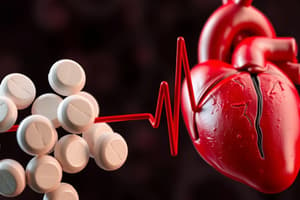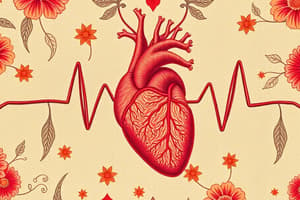Podcast
Questions and Answers
Explain the potential adverse effects of propranolol on the cardiovascular system.
Explain the potential adverse effects of propranolol on the cardiovascular system.
Propranolol can worsen congestive heart failure by directly suppressing myocardial contractility. It may also worsen cold extremities and Raynaud's disease, and may cause drug fever, rash, nausea, and interfere with glucose metabolism leading to hypoglycemia in those being treated for diabetes mellitus.
What is the recommended approach for discontinuing beta blockers to prevent withdrawal responses?
What is the recommended approach for discontinuing beta blockers to prevent withdrawal responses?
Beta blockers should be slowly tapered to prevent withdrawal responses.
How does amiodarone affect the conduction system of the heart?
How does amiodarone affect the conduction system of the heart?
Amiodarone depresses AV node conduction and the accessory bypass tracts.
What is the recommended preoperative dose of IV amiodarone for resistant ventricular tachycardia or ventricular fibrillation?
What is the recommended preoperative dose of IV amiodarone for resistant ventricular tachycardia or ventricular fibrillation?
What is the therapeutic blood concentration range for amiodarone?
What is the therapeutic blood concentration range for amiodarone?
What are some benign causes of perioperative cardiac arrhythmias?
What are some benign causes of perioperative cardiac arrhythmias?
What is the effect of anesthetic agents on cardiac arrhythmias?
What is the effect of anesthetic agents on cardiac arrhythmias?
How should pacemakers be managed in the preoperative assessment of chronic arrhythmias?
How should pacemakers be managed in the preoperative assessment of chronic arrhythmias?
What should be considered when managing chronic pharmacological treatment for arrhythmias?
What should be considered when managing chronic pharmacological treatment for arrhythmias?
What should be looked for when dealing with AICD (automatic implantable cardioverter-defibrillator) with pharmacological treatment?
What should be looked for when dealing with AICD (automatic implantable cardioverter-defibrillator) with pharmacological treatment?
Explain the potential side effects of lidocaine and its oral analogues, mexiletine and tocainide.
Explain the potential side effects of lidocaine and its oral analogues, mexiletine and tocainide.
What is the effectiveness of phenytoin in suppressing ventricular arrhythmias, and what potential side effects does it have?
What is the effectiveness of phenytoin in suppressing ventricular arrhythmias, and what potential side effects does it have?
Explain the effectiveness of flecainide and propafenone in suppressing different types of arrhythmias. What are their respective resemblances to other drugs?
Explain the effectiveness of flecainide and propafenone in suppressing different types of arrhythmias. What are their respective resemblances to other drugs?
How do beta blockers like propranolol and esmolol control arrhythmias, and what are their common side effects?
How do beta blockers like propranolol and esmolol control arrhythmias, and what are their common side effects?
Explain the impact of weakening sympathetic nervous system activity on patients with congestive heart failure.
Explain the impact of weakening sympathetic nervous system activity on patients with congestive heart failure.
Explain the potential causes of perioperative arrhythmias.
Explain the potential causes of perioperative arrhythmias.
How can hypokalemia and hypomagnesemia predispose to ventricular arrhythmias?
How can hypokalemia and hypomagnesemia predispose to ventricular arrhythmias?
What effect does increased sympathetic nervous system activity have on the threshold for ventricular fibrillation?
What effect does increased sympathetic nervous system activity have on the threshold for ventricular fibrillation?
How can bradycardia lead to ventricular arrhythmias?
How can bradycardia lead to ventricular arrhythmias?
What factors can induce arrhythmias in a failing left ventricle, and how can they be controlled?
What factors can induce arrhythmias in a failing left ventricle, and how can they be controlled?
Explain the potential side effects and uses of lidocaine in treating arrhythmias, and compare its effectiveness and side effect profile to quinidine and procainamide.
Explain the potential side effects and uses of lidocaine in treating arrhythmias, and compare its effectiveness and side effect profile to quinidine and procainamide.
What are the uses and potential adverse effects of procainamide, and how does it compare to quinidine and lidocaine?
What are the uses and potential adverse effects of procainamide, and how does it compare to quinidine and lidocaine?
Describe the uses and potential adverse effects of quinidine and its metabolism, and compare it to procainamide and lidocaine.
Describe the uses and potential adverse effects of quinidine and its metabolism, and compare it to procainamide and lidocaine.
What are the uses and potential adverse effects of class 1C drugs, and how can wide complex ventricular rhythm be treated?
What are the uses and potential adverse effects of class 1C drugs, and how can wide complex ventricular rhythm be treated?
Explain the uses and potential adverse effects of disopyramide and moricizine in treating arrhythmias.
Explain the uses and potential adverse effects of disopyramide and moricizine in treating arrhythmias.
What are the mechanisms of action of Class I antiarrhythmic drugs and their clinical uses?
What are the mechanisms of action of Class I antiarrhythmic drugs and their clinical uses?
Explain the mechanisms of action and clinical uses of Class II antiarrhythmic drugs.
Explain the mechanisms of action and clinical uses of Class II antiarrhythmic drugs.
Describe the mechanisms of action and clinical uses of Class III antiarrhythmic drugs.
Describe the mechanisms of action and clinical uses of Class III antiarrhythmic drugs.
What are the mechanisms of action and clinical uses of Class IV antiarrhythmic drugs?
What are the mechanisms of action and clinical uses of Class IV antiarrhythmic drugs?
Explain the potential proarrhythmic effects of antiarrhythmic agents and their treatments.
Explain the potential proarrhythmic effects of antiarrhythmic agents and their treatments.
Explain the mechanism of action of lidocaine in treating ventricular arrhythmias.
Explain the mechanism of action of lidocaine in treating ventricular arrhythmias.
What are the potential adverse effects of procainamide with chronic use?
What are the potential adverse effects of procainamide with chronic use?
What are the similarities and differences between quinidine and procainamide in terms of clinical use and metabolism?
What are the similarities and differences between quinidine and procainamide in terms of clinical use and metabolism?
What is the therapeutic use of disopyramide and what are its potential side effects?
What is the therapeutic use of disopyramide and what are its potential side effects?
When should moricizine be used and what proarrhythmic effects does it have?
When should moricizine be used and what proarrhythmic effects does it have?
What are the mechanisms of action of Class I antiarrhythmic drugs and their clinical uses?
What are the mechanisms of action of Class I antiarrhythmic drugs and their clinical uses?
Explain the mechanisms of action and clinical uses of Class II antiarrhythmic drugs.
Explain the mechanisms of action and clinical uses of Class II antiarrhythmic drugs.
Describe the mechanisms of action and clinical uses of Class III antiarrhythmic drugs.
Describe the mechanisms of action and clinical uses of Class III antiarrhythmic drugs.
What are the mechanisms of action and clinical uses of Class IV antiarrhythmic drugs?
What are the mechanisms of action and clinical uses of Class IV antiarrhythmic drugs?
Explain the potential proarrhythmic effects of antiarrhythmic agents and their treatments.
Explain the potential proarrhythmic effects of antiarrhythmic agents and their treatments.
Flashcards are hidden until you start studying
Study Notes
Cardiac Antiarrhythmic Drugs Overview
- Class 1A and 1C drugs such as quinidine and procainamide can lead to incessant ventricular tachycardia, especially at high doses
- Wide complex ventricular rhythm can be treated with class 1C drugs and calcium channel blockers like diltiazem and verapamil
- Quinidine, a class 1A drug, is effective for acute and chronic supraventricular arrhythmias, but has a low therapeutic index and adverse effects
- Procainamide, another class 1A drug, is used for ventricular tachyarrhythmias and may cause hypotension and SLE-like symptoms with chronic use
- Disopyramide, comparable to quinidine, is used for atrial and ventricular tachyarrhythmias and has anticholinergic side effects
- Moricizine, a phenothiazine derivative, is used for life-threatening ventricular arrhythmias and has proarrhythmic effects
- Lidocaine, primarily used for ventricular arrhythmias, has minimal effect on supraventricular tachyarrhythmias and is effective in suppressing re-entry arrhythmias
- Lidocaine’s mechanism of action involves delaying the rate of spontaneous phase 4 depolarization by preventing or diminishing the gradual decrease in K+ permeability
- Concurrent administration of phenytoin, phenobarbital, rifampin lowers blood levels of quinidine by enhancing liver clearance
- Quinidine and procainamide are both metabolized in the liver and excreted renally
- Lidocaine has a more rapid onset, greater therapeutic index, and better side effect profile than procainamide and quinidine
- Lidocaine's IV form has no preservative, while IM lidocaine has nearly complete absorption and a specific dosing regimen.
Studying That Suits You
Use AI to generate personalized quizzes and flashcards to suit your learning preferences.




